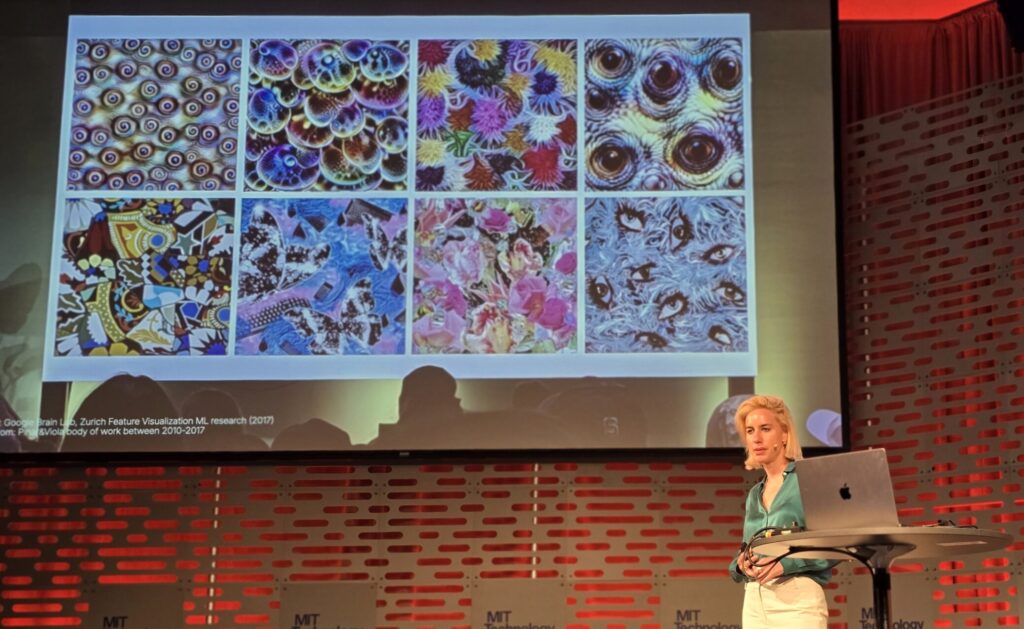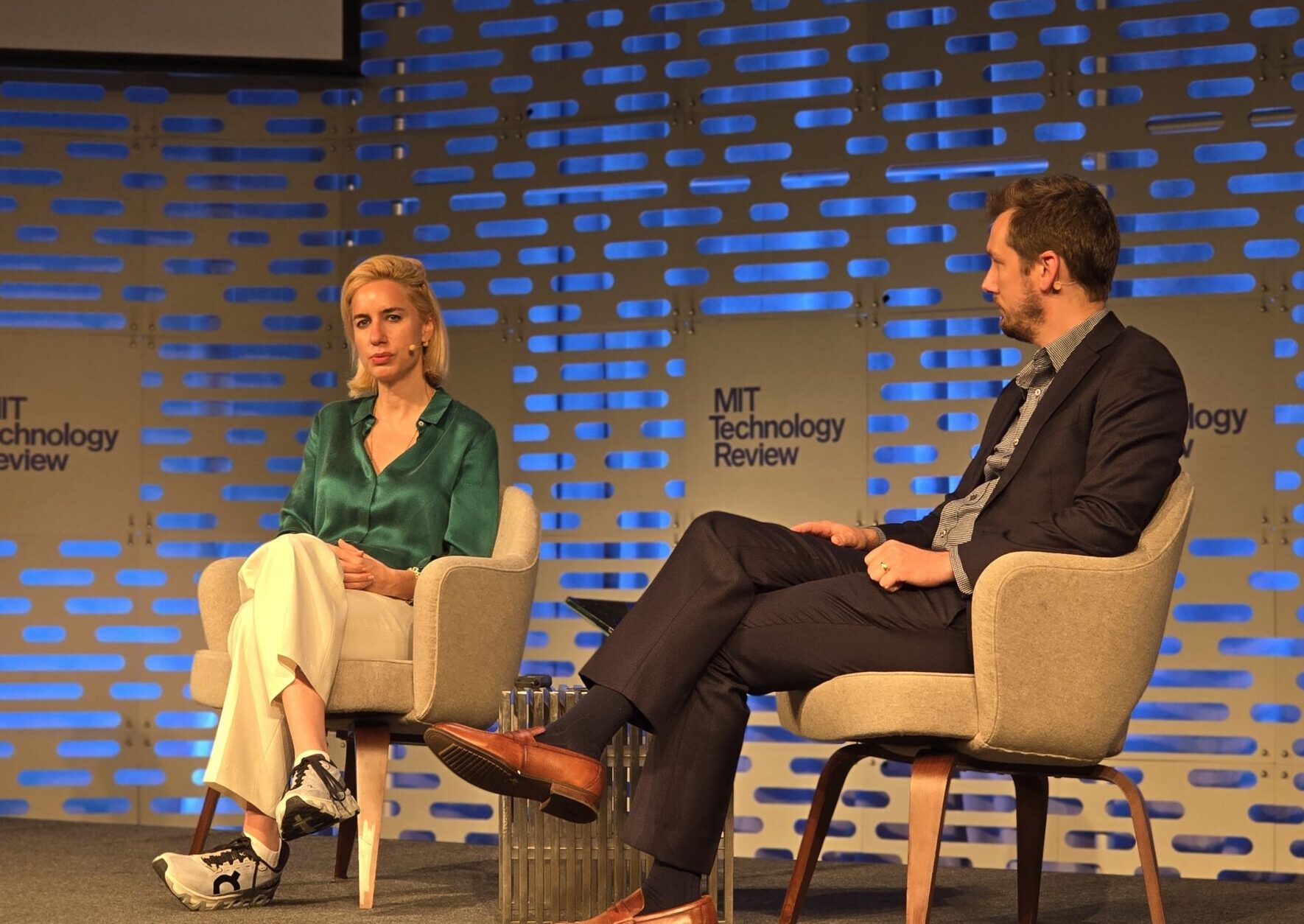Cambridge, MA – MIT EmTechAI: Pinar Demirgad, Co-founder & CEO of Cuebric, delivered a compelling talk on how AI is transforming the landscape of visual storytelling. Drawing from her unique experience as both an artist and entrepreneur, she explored the current capabilities, limitations, and future directions of generative AI in film and content creation.
From Artist to AI Innovator
- Demirgad began by highlighting her personal journey: as an artist, she witnessed Google’s early generative AI models unintentionally replicating her own artistic style, sparking both existential questions and inspiration. Rather than resisting, she embraced AI, co-founding companies to explore its creative potential.
- She led pioneering projects, such as the world’s first generative visual effects for a feature film and a high-budget generative AI commercial, cementing her role at the intersection of art and technology.

The Hollywood Challenge: Why Generative Video Isn’t Enough
- Demirgad explained that while generative video models from leading AI labs are impressive, they fall short for professional filmmaking. Hollywood productions require meticulous control over every visual detail-something current AI tools and models struggle to provide.
- She illustrated this with the example of LED wall virtual production (as seen in The Mandalorian), where environments are built in complex game engines like Unreal Engine or Unity. These workflows are expensive and demand specialized technical knowledge, making them inaccessible to most creators.
Cuebric’s Approach: Simplifying Complexity
- Cuebric’s innovation is a tool that transforms flat images into layered, parallax 3D environments at the push of a button, dramatically reducing the time, cost, and expertise needed to create virtual sets.
- Their system leverages multiple AI technologies-depth estimation, object detection, image generation, inpainting, outpainting, and 3D reconstruction-seamlessly orchestrated for the user.
- The tool is already being used in commercials, short films, and previsualization, accelerating production workflows and democratizing access to advanced visual effects.
The Golden Age of Applications
- Demirgad argued that the era of “model wars” is ending; with billions invested, foundational AI models are now widely available, including high-performing open-source options.
- The future lies in applications that “orchestrate” these models, offering unified, intuitive experiences for creators. She likened this shift to the rise of Canva, which made graphic design accessible to non-experts, predicting similar disruption in visual storytelling tools.
Orchestration, Not Just Generation
- Filmmakers and storytellers demand control, not just generation. Cuebric’s new orchestration OS enables users to:
- Precisely composite and manipulate every element in a scene
- Convert flat images into editable, 3D environments
- Import and animate custom 3D characters and props
- Break down scripts into visual assets, automating much of the production pipeline
- The system is designed for flexibility, allowing users to bring their own models or use Cuebric’s, and aims to unify the entire creative process under one roof.
Limitations of Current AI Tools
- Despite rapid progress, Demirgad cautioned that no AI tool is currently ready for final, high-fidelity film production. Key barriers include:
- Insufficient color depth (AI-generated images max out at 8-bit, while professional standards require 16-bit or more)
- Limited resolution and detail
- Difficulty in handling complex compositing, physics, and fine-grained control
- As a result, most adoption today is in planning, previsualization, and short-form content-not feature films.
Democratizing Creativity for the Next Generation
- Demirgad cited statistics showing that 60–69% of Gen Z want to be content creators. She sees the future as either:
- Everyone becoming a creator, or
- Tools becoming so simple that anyone can create high-quality content without technical barriers
- The goal is to empower not just professionals, but also everyday users-like her own mother, who always wanted to express herself creatively.
The Future: Unified, Accessible, Human-Centric Tools
- Demirgad envisions a future akin to the “Jarvis” AI from Avengers: Endgame: a single, voice- and gesture-driven system that orchestrates all aspects of visual storytelling, from concept to camera.
- She emphasized that while AI can accelerate and democratize creativity, the rigor and vision of the artist remain irreplaceable. Tools must enable, not replace, human creativity-avoiding the “normalization of mediocrity.”
- Ultimately, the impact of AI on storytelling will be measured not by technical novelty, but by its ability to move audiences and empower new voices.
Conclusion
Pinar Demirgad’s talk underscored that the future of visual storytelling lies in AI-powered orchestration: tools that unify and simplify complex processes, put creative control in the hands of all users, and maintain the highest standards of artistic rigor. While technical limitations remain, the next wave of innovation will be defined not by new models, but by new experiences-making creativity accessible, powerful, and deeply human.
For more information, please visit the following:
Website: https://www.josephraczynski.com/
Blog: https://JTConsultingMedia.com/
Podcast: https://techsnippetstoday.buzzsprout.com
LinkedIn: https://www.linkedin.com/in/joerazz/


Leave a Reply
You must be logged in to post a comment.